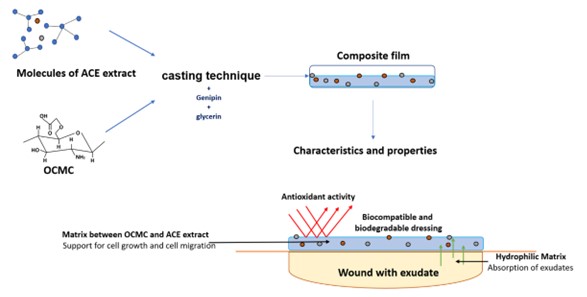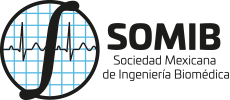Allium cepa: A Natural Enhancer of Wound Closure and Cell Viability in O-Carboxymethyl Chitosan Films
DOI:
https://doi.org/10.17488/RMIB.46.1.1484Keywords:
Allium cepa, O-carboxymethyl chitosan, tissue regeneration, wound healingAbstract
Wound healing and cicatrization after tissue damage are essential for the body's recovery process. Regenerative medicine has been focused on finding biocompatible polymeric materials reinforced with natural active substances, which have healing, anti-inflammatory, and antimicrobial properties. This study aimed to enhance O-carboxymethyl chitosan films with Allium cepa extracts, endemic to Chihuahua, Mexico. The extract's properties were analyzed, and the results show the saponin, flavonoid, and terpenoid contents and an antioxidant activity of 70 %. Cicatrization in vitro was also studied, and the results show that a 15 mg/mL concentration of the Allium cepa extracts improved cellular proliferation and migration in fibroblasts, which was further confirmed in a cellular viability study of the O-carboxymethyl chitosan films loaded with 7 and 20 wt. % of the extract, which showed a higher percentage of cellular viability after three days. The study's results suggest that low extract concentrations can be used as an active ingredient in polymeric biomaterials to aid skin cicatrization.
Downloads
References
L.-E. Valencia-Gómez, et al., “Characterization and evaluation of a novel O-carboxymethyl chitosan films with Mimosa tenuiflora extract for skin regeneration and wound healing,” J. Bioact. Compat. Polym., vol. 35, no. 1, pp. 39-56, 2020, doi: https://doi.org/10.1177/0883911519885976
L. E. Valencia-Gómez, et al., “Comparative Study of the Antibacterial, Biodegradable, and Biocompatibility Properties of Composite and Bi-Layer Films of Chitosan/Gelatin Coated with Silver Particles,” Materials, vol. 16, no. 8, 2023, art. no. 3000, doi: https://doi.org/10.3390/ma16083000
X.-G. Chen, Z. Wang, W.-S. Liu, H.-J. Park, “The effect of carboxymethyl-chitosan on proliferation and collagen secretion for normal and keloid skin fibroblasts,” Biomaterials, vol. 23, no. 23, pp. 4609-4614, 2002, doi: https://doi.org/10.1016/S0142-9612(02)00207-7
L. Weng, A. Romanov, J. Rooney, W. Chen, “Non-cytotoxic, in situ fellable hydrogels composed of N-carboxymethyl chitin and carboxymethyl chitosan films for potential use in wound care application,” Biomaterials, vol. 29, no. 29, pp. 3905-3913, 2008, doi: https://doi.org/10.1016/j.biomaterials.2008.06.025
S. Sanyal, P. K. Vemula, S. Law, “Investigating the therapeutic potential of Allium cepa extract in combating pesticide exposure induced ocular damage,” Exp. Eye Res., vol. 42, 2024, art. no. 109816, doi: https://doi.org/10.1016/j.exer.2024.109816
H.-S. Lee, et al., “Anti-inflammatory effects of Allium cepa L. peel extracts via inhibition of JAK-STAT pathway in LPS-stimulated RAW264.7 cells,” J. Ethnopharmacol., vol. 317, 2023, art. no. 116851, doi: https://doi.org/10.1016/j.jep.2023.116851
D. E. Garcia, F. Ojeda, “Evaluación de los principales factores que influyen en la composición fitoquímica de Morus alba (Linn.). I. Análisis cualitativo de metabolitos secundarios,” Pastos y Forrajes, vol. 26, no. 4, pp. 335–343, 2003. [Online]. Available: https://payfo.ihatuey.cu/index.php?journal=pasto&page=article&op=view&path%5B%5D=814
X. Lu, et al., “Determination of total phenolic content and antioxidant capacity of onion (Allium cepa) and shallot (Allium oschaninii) using infrared spectroscopy,” Food Chem., vol. 129, no. 2, pp. 637-644, 2011, doi: https://doi.org/10.1016/j.foodchem.2011.04.105
P. Sharma, et al., “Green Synthesis of Silver Nanoparticle Capped with Allium cepa and Their Catalytic Reduction of Textile Dyes: An Ecofriendly Approach,” J. Environ. Polym. Degrad., vol. 26, no. 5, pp. 1795-1803, 2017, doi: https://doi.org/10.1007/s10924-017-1081-7
X. Lu, “Determination of Antioxidant Content and Antioxidant Activity in Foods using Infrared Spectroscopy and Chemometrics: A Review,” Crit. Rev. Food. Sci. Nutr., vol. 52, no. 10, pp. 853-875, 2012, doi: https://doi.org/10.1080/10408398.2010.511322
A. Bhattacharya, “High-temperature stress and metabolism of secondary metabolites in plants. Effect of High Temperature on Crop Productivity and Metabolism of Macro Molecules,” in Effect of High Temperature on Crop Productivity and Metabolism of Macro Molecules, Cambrige, United State: Elsevier, 2019, ch. 5, pp. 391-484, doi: https://doi.org/10.1016/B978-0-12-817562-0.00005-7
R. M. Pérez, et al., “Actividad antioxidante de los alcaloides de Bocconia arborea. Estudio sobre seis métodos de análisis,” Ars Pharm., vol. 44, no. 1, pp. 5–21, 2002, doi: https://revistaseug.ugr.es/index.php/ars/article/view/5122
S. Baliyan, et al., “Determination of Antioxidants by DPPH Radical Scavenging Activity and Quantitative Phytochemical Analysis of Ficus religiosa,” Molecules, vol. 27, no. 4, 2022, art. no. 1326, doi: https://doi.org/10.3390/molecules27041326
M.A. Rojas-Yañez, et al., “Composite scaffolds of chitosan/polycaprolactone functionalized with protein of Mytilus californiensis for bone tissue regeneration,” AIMS Mater. Sci., vol. 9, no. 3, pp. 344-358, 2022, doi: https://doi.org/10.3934/matersci.2022021
N. Arrieta-Sandoval, et al., “Effect of Ag2S-BSA nanoparticle size on 3T3 fibroblast cell line cytotoxicity,” J. Nanopart. Res., vol. 22, 2020, art. no. 106, doi: https://doi.org/10.1007/s11051-020-04834-6
A. Areesanan, et al., “Pharmacological in vitro profiling of Buddleja officinalis flower extracts in the context of dry eye disease,” Biomed. Pharmacother., vol. 181, 2024, art. no. 117685, doi: https://doi.org/10.1016/j.biopha.2024.117685
E. Yadav, et al., “Antioxidant and anti-inflammatory properties of Prosopis cineraria based phenolic rich ointment in wound healing,” Biomed. Pharmacother., vol. 108, pp. 1572-1583, 2018, doi: https://doi.org/10.1016/j.biopha.2018.09.180
A. Joshi, V. K. Joshi, D. Pandey, S. Hemalatha, “Systematic investigation of ethanolic extract from Leea macrophylla: implications in wound healing,” J. Ethnopharmacol., vol. 191, pp. 95-106, 2016, doi: http://dx.doi.org/10.1016/j.jep.2016.06.034
G. Hernández-Pasteur, et al., “Evaluación in vitro de la Actividad Cicatrizante y Antibacteriana de Extractos de Buddleja cordata Kunth y Vismia baccifera (L.) Triana & Planch,” Rev. fitotec. mex., vol. 42, no. 2, pp. 93-99, 2019. [Online]. Available: https://www.scielo.org.mx/scielo.php?script=sci_arttext&pid=S0187-73802019000200093
Y. Cao, et al., “Quercetin inhibits fibroblasts proliferation and reduces surgery-induced epidural fibrosis via the autophagy-mediated PI3K/Akt/mTOR pathway,” Bioengineered, vol. 13, no. 4, pp. 9973-9986, 2022, doi: https://doi.org/10.1080/21655979.2022.2062530
C. Chittasupho, et al., “Effects of Quercetin and Curcumin Combination on Antibacterial, Antioxidant, In Vitro Wound Healing and Migration of Human Dermal Fibroblast Cells,” Int. J. Mol. Sci., vol. 23, no. 1, 2022, art. no. 142, doi: https://doi.org/10.3390/ijms23010142

Downloads
Published
How to Cite
Issue
Section
License
Copyright (c) 2025 Revista Mexicana de Ingenieria Biomedica

This work is licensed under a Creative Commons Attribution-NonCommercial 4.0 International License.
Upon acceptance of an article in the RMIB, corresponding authors will be asked to fulfill and sign the copyright and the journal publishing agreement, which will allow the RMIB authorization to publish this document in any media without limitations and without any cost. Authors may reuse parts of the paper in other documents and reproduce part or all of it for their personal use as long as a bibliographic reference is made to the RMIB. However written permission of the Publisher is required for resale or distribution outside the corresponding author institution and for all other derivative works, including compilations and translations.







